Baracoa to Puerto Vita
16th - 18th April 2004
We decided to forego the pleasure of going to the viewpoint over the American Naval base at Guantanamo and headed on to the road through the mountains to Baracoa. At this point Christine took over the driving and spent the next couple of hours getting plenty of practice in changing between second and third gear (it's not often we get the chance to drive now), as we wended our way around hairpin bends. Along the way, as soon as they heard a car approaching, locals leapt out into the road to wave the goods they had for sale, mostly bananas, oranges and strange cones made of palm leaves, so there was plenty of swerving practice too! Finally our curiosity got the better of us and we stopped and bought two of the cone things - which turned out to have a sweet inside called cucurucho, a mixture of coconut, guava, orange and of course lots of sugar. It was delicious but difficult to eat without a spoon as it was very sticky.
On the way to Baracoa, sometimes the fog was really thick but luckily it was always coming from a truck or bus which had seen better days! We were surprised to find ourselves following a vehicle with the Welsh word for ambulance on the back and a Welsh flag on the side. It was donated by a Welsh Charity and when they stopped in front of us to let out passengers, who didn't seem to be patients (anything goes in Cuban road transport), we pulled up alongside to take a photo and tell them we were from Wales.

Cuban Fog!

At least these people had heard of Wales!

A driving challenge - Baracoa's Malecon on Carnival Day!

The Street where we lived in Baracoa.
Here everything was sold in pesos. It was refreshing to find ourselves in a town which didn't seem to have been affected too much by tourism. After buying a glass (which more closely resembled a rubber bucket), we bought beer to wash down the pig sandwiches, at a cost of 6 pesos (20p). We were given a lecture by one of the locals and finally gathered that he was telling us that we could buy our beer for only 2 pesos from one of the other stalls where, as supplies got low, they shipped in more beer in tankers, which drove right through the middle of the crowds.

A pig in the city!

Welcome to the House of Fun!
We headed back out to the carnival festivities with our buckets ready to fill with beer, to enjoy the Cuban music and watch the locals dancing. We decided we'd need some lessons if we weren't to show ourselves up! Exhausted by the driving we left quite early, around 10 pm. When we awoke next morning at 7 am, the music was still to be heard!
Next morning we paid a visit to the market on the sea front to pick up some fresh vegetables to take back to the boat. For about a dollar, we had half a dozen tomatoes, half a dozen cucumbers, half a dozen peppers, some shadow benny (like coriander) and some weird hairy potato things. We then took our first ride on a bici-taxi back to the house. We were told the fare was one dollar but when Phil took out his pesos, he said it would be 5 (about 20 cents). After saying our goodbyes to Idania and her family, we hit the road to Moa which was littered with huge potholes and crowds of people trying to get to the carnival in Baracoa. The countryside was very scenic but there was little of interest to stop for, so we drove on to Moa, enjoying the views. Just outside of Moa, a not very scenic nickel mining and smelting town (no photographs allowed!), an alarm began to sound on the car and one of the warning lights came on. We decided to drive on to the petrol station which we knew was in the town, fearing the fan belt had gone. Two very helpful workers in the garage took a look under the bonnet with Phil but they couldn't see anything amiss and the alarm stopped as suddenly as it started. They then wanted to check the tyres as they were worried one seemed very low and topped it up. Then they let us use the staff bathroom and gave us free coffee - what service!
After Moa the road got much better for a while and we picked up an old lady and gave her a lift, which was quite stressful as we couldn't understand where she wanted to go (turned out to be only a couple of miles to the next hoard of people waiting for lifts) and neither of the car's back doors seemed to open very well - maybe she thought she was being abducted! When we reached Mayari, we stopped in the dodgiest motel in the world, where we foolishly ate a very bad meal. If I'd seen the toilets before we ate, we wouldn't have stopped! Anyway we lived to tell the tale.
Once we turned off the main Holguin road, onto the road to Banes, the road quickly became a nightmare, with no surface at all in many places. After a few miles we stopped to ask someone if the road would get any better and they said it did, so we persevered. Soon the road did get better, but only in sections, interspersed with stretches of unsurfaced road again. We passed cowboys and sheepboys on the way and finally as we turned off the Banes road towards the tourist centre of Guardalavaca, we arrived on a better road, but one which had no signposts. We finally found the road we were looking for to the Taina Indian Village we wanted to visit. On the junction a lady was waiting with her young son and we stopped to give them a lift, knowing that this time it had to be less stressful as the road we were taking was a dead-end.
Graciela and her family were such lovely and friendly people and after we'd bumped our way up the terrible road to the village of Chorro de Maita where they lived, she invited us to her house for coffee. We had to leave the car on the road and walk a couple of hundred yards to her house.
Her family were very welcoming and she proudly showed us around her home, in which the floors were constructed of mud. We met her husband Evideo and their sons Yosbani and Yunier. Evideo immediately set to work cutting down coconuts for us from their garden while Graciela took us up the hill to see the view of the sea. Roaming in the garden was their pig and their small kitten, which enjoyed sharing the coconut.
Evideo showed us how he made charcoal and demonstrated their sugar cane press, meanwhile Graciela proudly made us Cuban coffee on their charcoal stove in the kitchen. It was amazing to see inside their house. We enquired if they got much rain there, as the wall, made of wooden slats, had lots of gaps and the mud floor must be terrible if wet but Evideo said it hadn't rained for four months.
Their water came from a mains pipe at the bottom of the garden, better than many areas we've seen on our travels, where water is delivered by ox-cart due to an extreme water shortage.
We had a fantastic time with the family, they were so friendly. We asked if we could pay for the coffee but they wouldn't take anything. Finally when we insisted on giving them something, they said if we had any old clothes they'd be grateful. Unfortunately we didn't have much with us, as we were travelling light but were able to pass on one of Phil's T-shirt to Evideo and we gave Graciela the hat we'd bought in Barracoa, which had made Christine look one of the flowerpot men but looked much more stylish on Graciela. We gave them all the remaining snacks we had in the car as well.
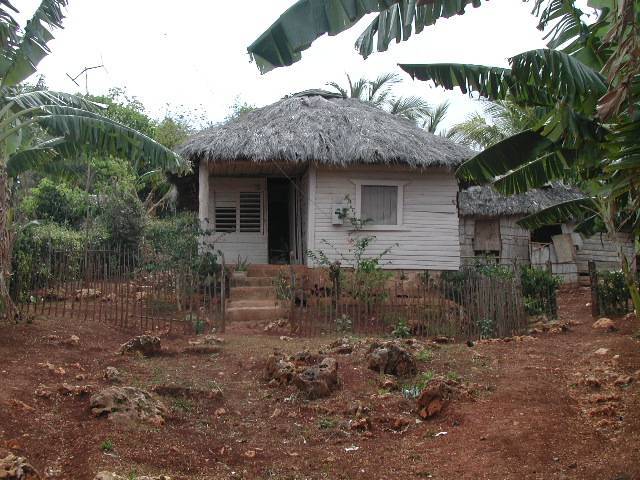
Graciela's House
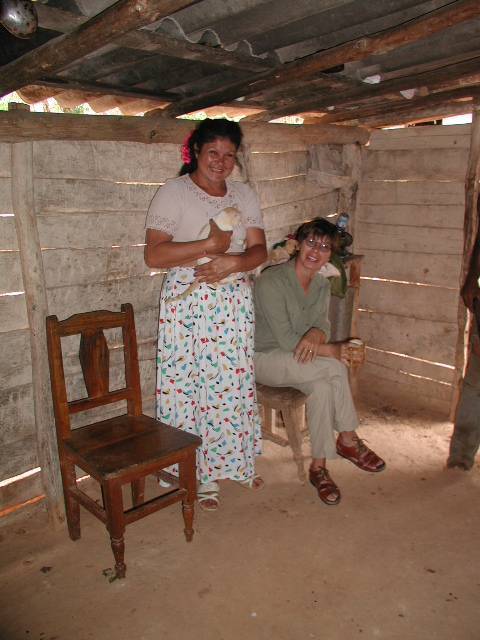
Graciela in her kitchen.
We visited the nearby Taina village, which was really a bit of a theme park, showing aspects of village life of the indigenous people of Cuba, before the Spanish arrived.
As we came out of the museum, Graciela was waiting for us again, loaded down with a bag containing more coconuts, coffee and a dozen lemons for us. She was lovely and so generous when they have so little. We were sad to leave.
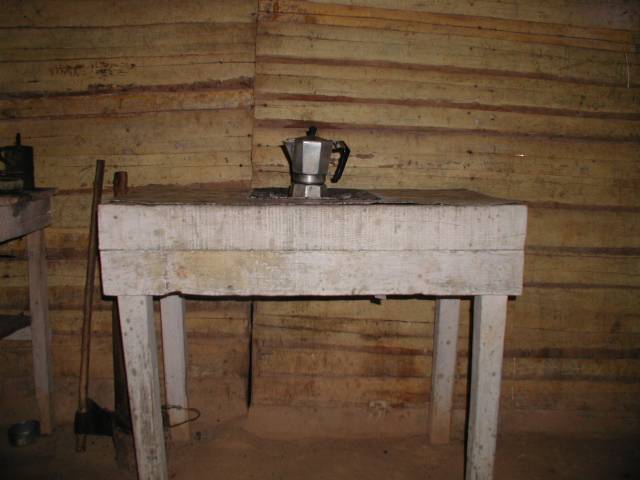
Preparing strong Cuban coffee on the charcoal stove.
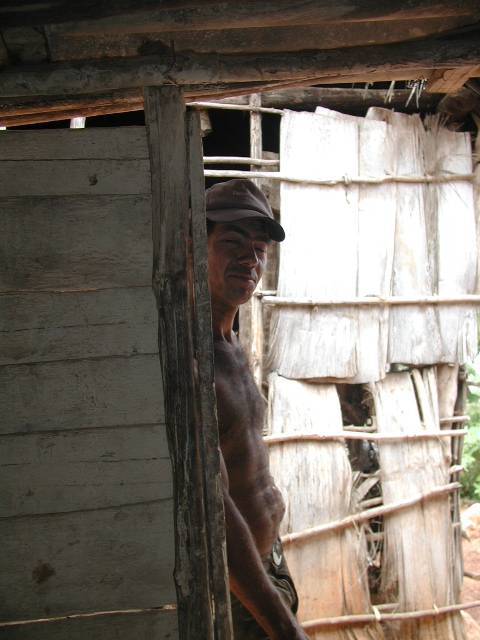
Evideo outside his workshop.
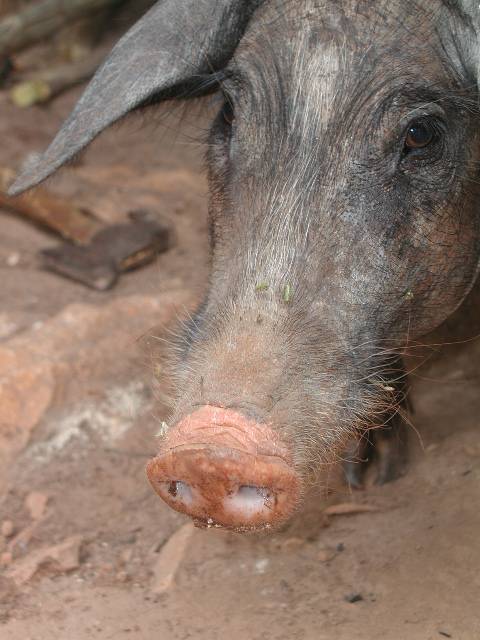
Even the family's pig was friendly!
On our way back to the marina and spotted Ernestina, the lady from the marina office and the Port Captain on the junction, hopefully waiting for transport. We offered them a lift but were glad when they declined as Ernestina was heading to Holguin an hour away and the Port Captain to his house in Moa from where we'd just come (good luck!).